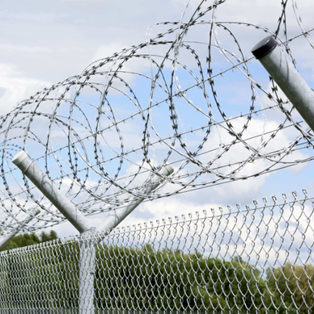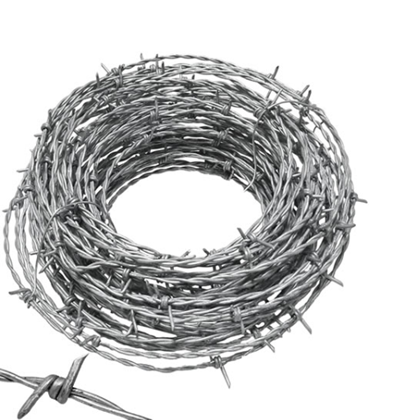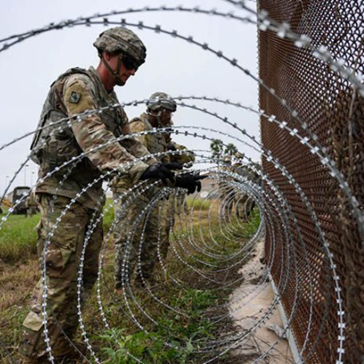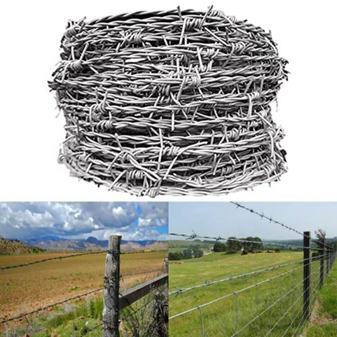-
 Liu
Hi there! Welcome to my shop. Let me know if you have any questions.
Liu
Hi there! Welcome to my shop. Let me know if you have any questions.
Your message has exceeded the limit.

What Was Barbed Wire Used For?
2025-10-01 17:24:40
Often referred to as the devil's rope, barbed wire changed forever the way humans demarcate boundaries and secure resources. Having been invented sometime in the late 19th century, barbed wire was a land-grabbing technology that converted vast open spaces into controlled territories. But what was barbed wire used for, and why did it gain so much prominence across industries and societies? This blog chronicles the fascinating history and diverse applications of barbed wire, the story of this simple yet brilliant invention that, in many ways, has come to symbolize both order and disorder. Whether you are curious about its influence in agriculture, security, or the military, this article provides insights into the thousand-year legacy of barbed wire throughout human history. Find more info now
History of Barbed Wire
The history of barbed wire dates back to the mid-19th century, when the need to keep livestock became a pressing concern. Joseph F. Glidden is often given full credit for its invention, since he received a patent for his design in 1874. In his design, the sharp barbs were twisted around the wire strand to make the fencing both practical and durable. It did not take long for barbed wire to gain popularity among farmers and ranchers due to its affordability and ease of installation compared to traditional forms of fencing. The barbed wire, however, could still be put to many more uses, among which were the fortification of military camps and property boundaries. Thus, barbed wire became one of those truly distinguishing inventions in modern history.
Invention and Early Use of Barbed Wire
The invention of barbed wire marked a significant milestone in land use and property management, meticulously orchestrated in the latter half of the 19th century. Joseph Glidden is said to have obtained a patent for the modern form of barbed wire in 1874, forever changing the idea of fences with his simple yet brilliant design. His design characteristically consists of one strand of wire with sharp barbs twisted around it and fixed in place by a second wire so that the position of the barb would not change, making it cheap and durable and quickly becoming popular in both town and country. Barbed wire made fencing more affordable and easier to install; this surely was another catalyst for the transformation of frontier agriculture, as cattle could be more efficiently protected and confined by means of wire fences.
Barbed wire meant much more than agriculture alone. Historical evidence suggests that by the late 1880s, barbed wire production had increased significantly, with annual production reaching millions of pounds to meet high demand. According to the best estimate, more than 263,000 miles of barbed wire were installed in the United States alone in 1880. Its use became instrumental in settling the American West, where the vast, unpopulated tracts of land were being claimed and fenced for agriculture and grazing. Barbed wire also found its way into military uses and was perhaps better known for its extensive use during the Great War for trench defense (its versatility as a practical weapon and strategic tool). By meeting economic, agricultural, and territorial needs, barbed wire hence became one of the most important inventions of the industrial age. These inventive ideas really gave barbed wire its undying name as a historic artifact.
Barbed Wire in Agriculture
Barbed wire gave a new dimension to the agricultural sector by providing an easy and cheap option for fencing large plots of land. Regarding its invention in the 19th century, it helped farmers worldwide define clear boundaries of their farms, protect crops from grazing animals, and restrain the animals from roaming. Before the invention of barbed wire, traditional wooden fences were expensive and labor-intensive, making large-scale farming an uphill task.
Today, barbed wire still acts a vital role in modern farming. According to recent statistics, the global barbed wire market was approximately worth $1.5 billion in 2022 and is forecasted to grow steadily in line with the rising global demand for agricultural products. In harsher climate zones, farmers primarily use high-tensile barbed wire fencing due to its durability and minimal maintenance requirements. The fencing can vary in size but generally falls within the range of 12.5 to 15.5-gauge wire, forming an essential barrier to impede the movement of cattle, sheep, and other livestock, thereby conserving resources and enhancing efficiency.
Modern barbed wire benefits from design features such as corrosion-resistant coatings, which extend its lifespan and enhance its suitability for long-term agricultural applications. Together with sustainable land-use practices, barbed wire supports optimal land use and food security by preventing overgrazing and crop destruction. Due to a low cost and a moderately high ceiling of utility, it has been instrumental in ensuring the viability of agricultural operations for both small and large-scale farmers globally.
Military Applications of Barbed Wire
When we discuss the history of barbed wire, we must also remember the military operations and, almost always, large-scale battles. Being flexible, cost-effective, and efficient, it finds its applications in many situations, providing the system with some defensive or strategic advantage. Listed below are five primary uses of barbed wire by the military:
Perimeter Defense
In its conventional use for securing military installations and encampments, barbed wire serves as a physical barrier to prevent unauthorized persons from intruding. It slows the advances of the enemy, hence giving a huge tactical advantage to the defenders.
Trench Warfare
Barbed wire was used extensively in trench warfare during World War I. Positioned along the front lines, it prevented enemy forces from striding freely into opposing territory and herded them into kill zones established by premeditation.
Obstacle Creation
Typically, barbed wire is used to create field obstacles, such as entanglements, that delay advancing troops and vehicles. They are placed strategically to restrict movement and grant time for defensive preparations.
Crowd Control
A method by which military forces have employed barbed wire during conflicts or protest situations to control crowds without using lethal force. Temporary fences help to manage large groups of people while maintaining order and reducing casualty rates.
Demarcation of Key Areas
Barbed wire is a prime ingredient to marking off restricted areas or borders in conflict zones. This application is most crucial in separating hostile territories and ensuring control over access to vital areas.
Its interesting versatility has rendered barbed wire a valuable asset to the military, and it is still used today due to its ease of deployment and efficiency in various strategic applications.
Types of Barbed Wire
Various types of barbed wire are manufactured to serve distinct purposes and require varying standards. Below is a detailed list of the common kinds of barbed wire and their characteristics:
Single Twist Barbed Wire
The two-wire design has barbs fixed at interspersed intervals. In the simplest form of fencing and low-security barriers, this is considered the most cost-effective option. The single twist offers moderate strength and durability, which are sufficient for rural and agricultural areas.
Double Twist Barbed Wire
Made with two interwoven wire strands along with barbs, this type of barbed wire is stronger and more durable than the single twist. The double twist design provides enhanced security against forced entry and is, therefore, ideal for high-security areas, such as military sites and property boundaries. The resistance offers that extra protection from intrusion.
PVC-Coated Barbed Wire
These are barbed wires that have an additional PVC coating running through the steel wires. The coating enhances the durability of the wire by protecting it from rusting, corrosion, and environmental factors such as rain and sunlight. It is typically used in areas prone to severe weather conditions and in applications where appearance also matters.
Concertina Wire
Used in high-security applications, concertina wire is barbed wire formed into large coils that expand into a helical shape. The equipment creates barriers that are among the most difficult to overcome. The wire is heavily used for prisons, military installations, and secured borders.
Electric Barbed Wire
The barbed-wire fence offers an electric shock when touched. It is a better security option for deterring trespassers and cattle. Because of the ability of electric barbed wire to combine physical and psychological deterrents, it is widely used in prisons, private estates, and highly restricted areas.
High-Tensile Barbed Wire
High-tensile barbed wire, made of high-strength steel, is considered the most durable type of barbed wire and the least likely to stretch or break under pressure. This type of barbed wire is particularly suited for perimeter fencing over vast areas, especially on farms and ranches, as it requires less maintenance and can withstand severe environmental conditions.
Data and Cost Analysis
Stamina
Double Twist and High-Tensile barbed wire represent the most durable type, often being able to last up to 20-30 years if properly maintained.
Cost Range
Single Twist Barbed Wire: $40-$60 per roll (1320 feet).
PVC Coated Barbed Wire: $70-$100 per roll (1000 feet).
Concertina Wire: $150-$200 per roll (50 feet, expanded).
Security Applications
Concertina Wire and Electric Barbed wire are preferred for ensuring maximum security, as they are the strongest and most deterrent at the same time.
Understanding the different types of barbed wire and their relevant applications and costs will enable individuals or organizations to make informed decisions corresponding to their fencing or security needs.
Different Variants of Barbed Wire
Several types of barbed wire cater to different needs and feature distinct characteristics and advantages. The following are five common types of barbed wire:
Single-Strand Barbed Wire
Description: Constructed from one strand of wire, the barbs are twisted into the wire at uniform intervals.
Applications: Light fencing applications such as agriculture and livestock containment.
Average Cost: $30-$50 for 50 feet.
Double-Strand Barbed Wire
Description: Consisting of two wire strands twisted together for extra strength and durability.
Applications: Generally used in farm, ranch, and boundary fencing.
Average Cost: $40-$70 for 50 feet.
High-Tensile Barbed Wire
Description: Being from high-tensile steel, the barbed wire is more durable and stretches less.
Applications: Mostly used for permanent security gardens and in places where extreme weather prevails.
Average Cost: $60-$100 for 50 feet.
PVC-Coated Barbed Wire
Description: Over the wire features a protective PVC coating that resists rust and provides enhanced durability.
Applications: Installed in coastal areas or high-humidity areas to prevent corrosion.
Average Cost: $70-$120 for 50 feet.
Electric Barbed Wire
Description: Builds in electric current within the barbs for increased security and deterrence.
Applications: Mainly used for securing places like prisons and military installations.
Average Cost: $100-$150 for 50 feet.
A well-chosen selection of fencing types, based on function, durability, and price, will effectively address the fencing requirements. Each offers specific benefits for various scenarios to ensure optimal performance and longevity.
Comparative Uses of Barbed Wire Types
Barbed Wire Type | Key Features | Primary Uses |
High Tensile Barbed Wire | Strong, durable, resists sagging | Agricultural fencing, extreme weather areas |
PVC-Coated Barbed Wire | Rust-resistant, aesthetic appeal | Industrial, decorative, and outdoor fencing |
Galvanized Barbed Wire | Zinc-coated, corrosion-resistant | Outdoor use, long-lasting fencing |
Reverse Twisted Wire | Stronger, reduces sagging | High-security areas, harsh conditions |
Electric Barbed Wire | Delivers mild shocks | High-security zones, intruder deterrence |
Single Strand Wire | Lightweight, basic security | Agricultural fencing, livestock control |
Double Strand Wire | Stronger, higher security | Prisons, military, and high-security areas |
Concertina Wire | Coiled, razor-sharp barbs | Military, border security, critical zones |
4-Point Barbed Wire | Four sharp points for extra deterrence | Close-quarters livestock containment |
2-Point Barbed Wire | Two sharp points, economical | General agricultural use |
Durability and Material Considerations
Purpose and product choice are never far from the minds of durability and material. In our consideration, these were the five main points:
Zaratán Coating
Details: A galvanic coating ensures the barbed wire resists rust and corrosion, making it suitable for outdoor and damp settings.
Data: Depending on the zinc coating thickness and environmental exposure, zinc-coated wires may last for even 20-25 years.
High-tensile Strengths
They do not know how to break. A wire with high tensile strength, when subjected to tension or pressure, bears it better. So, they carry out their job even more reliably than ordinary wires.
Data: A wire of high tensile strength can bear a break load of between 1000 and 1200 pounds.
Wire Gauge
The diameter of the wire determines its strength, which also affects its resistance to wear. The lower the wire gauge, the thicker and more durable the wire.
Data: Wire gauges from 12 to 16 are measured with 12 gauges; a little more robust and, therefore, more durable.
UV Resistance
Details: In some barbed wire types, UV-resistant coatings prevent material degradation after long durations in sun exposure.
Data: Such UV-resistant finishes would add 5-10 years to the wire in the sunny climate.
Material Composition
Details: The composition of metals will determine how durable it is, how lightweight, and the degree of maintenance needed.
Data: Stainless steel wire would be more corrosion resistant than almost all other metals and will last over 30 years in good cases, whereas the other metals would get corroded in less than 5 years.
By considering these factors, users can ensure they invest in barbed wire that aligns best with their specific needs and environmental conditions.
Barbed Wire Fencing Solutions

Barbed wire fencing is one of the best practical and efficient barriers for property demarcation, livestock containment, and perimeter security. Mixing the advances of today with whatever guarantee barbed wire has shown for decades, here are a few key facts and current information about barbed wire fencing options:
1. Types of Barbed Wire
Traditional Double-stranded Wire: Mostly for agricultural uses; it has durability and reasonable tensile strength.
High-tensile Barbed Wire: More resistant to stretching or breaking and suitable for security functions.
PVC-Coated Barbed Wire: High corrosion resistance and better appearance; used in urban and industrial applications.
2. Durability and Lifespan
Galvanized, depending upon the climatic conditions, it can last around 15-20 years, whereas due to corrosion resistance, PVC-coated wire lasts 5-10 years longer.
Stainless steel barbed wire will last over 30 years with minimal maintenance, especially under non-extreme conditions.
3. Security Features
Studies reveal that, compared to high-tensile barbed wire installations, perimeter breaches can be reduced by up to 40% in traditional barbed wire systems.
Razor wires or electrification of the fence make it impenetrable as a hindrance to any intrusion attempts.
4. Cost Efficiency
The cost of installation used to range from $1.50 to $2.50 per linear foot for standard barbed wire fencing, but this depends on the material grade used and the difficulty of installation.
It is usually much more costly ahead of time to use high-tensile wire or PVC-coated wire, and to maintain, they will pay considerably less.
5. Eco-friendly Options
In an attempt to lessen the environmental impact, the manufacturers do put an increasing amount of recycled material in the composition of barbed wire.
PVC-coated wires are now being designed with more sustainable and biodegradable materials to enhance their environmental compatibility.
6. Applications
Agricultural Fencing: Primarily used for livestock-draught animals such as cattle and sheep, to prevent their escape.
Industrial and Commercial Use: Acts as an excellent barrier for warehouses, factories, and restricted zones.
Personal Property Security: Increasingly used for restricting access to residential areas.
Utilizing the latest technologies and advances, barbed wire fencing-based solutions can be easily customized to meet the diverse needs of customers, offering enhanced security, longevity, and cost-effectiveness. For the best results, consult fencing experts so they can work with you on determining which of the materials and installation methods will be most appropriate for your requirements.
Importance of Barbed Wire Fences in Livestock Management
The role of barbed wire fences in agricultural operations is paramount for the safety, control, and efficiency of livestock management. Here are the five primary reasons why barbed wire fencing is deemed necessary:
Containment of Livestock: Barbed wire fences effectively contain livestock within a designated area, preventing them from straying onto roads or neighboring lands, which could jeopardize both the safety of the animals and the public.
Protection from Predators: An adequately constructed and maintained barbed wire fence acts as a good deterrent to predatory animals, providing a physical barrier that is problematic for such animals to breach.
Cost-Effectiveness: Barbed wire fencing offers a cheap method of fencing large tracts of land for livestock as compared to other methods, yet it holds up well with proper installation.
Easy Maintenance and Longevity: Barbed wire fences are built to withstand all weather conditions and require little upkeep. Usually, a simple periodic review maintains their effectiveness for quite an extended period.
Controlled Grazing: Barbed wire fences serve to divide pastures and facilitate rotational grazing methods that optimize land use, improve grass regrowth, and maintain soil health.
These advantages make barbed wire fencing a priceless tool for farmers or livestock managers working to increase the operational efficiency of any establishment while protecting the animals therein.
Barbed Wire in Property Protection
Barbed wire is favored by many for its security benefits, primarily due to its economy, durability, and high level of security. As it serves as an immediate deterrent to unauthorized intrusion, it is a popular choice for protecting homes, commercial establishments, and industrial facilities. Some five advantages of barbed wire for property protection are:
Deterrence Against Intruders: The sharp barbs serve to dissuade anyone from entering, whether from a physical or psychological perspective.
Cost-Effectiveness: As one of the least expensive security fencing options, barbed wire remains one of the most effective ways to deter intruders.
Ease of Installation: The simple installation of barbed wire, with minimal use of specialized equipment, renders labor and setup costs comparatively low.
Durability: Barbed wire with galvanized steel can last longer, withstanding weather and corrosion.
Versatility: Barbed wire can be utilized according to various terrains and property types, including rural areas, urban boundaries, and high-security zones.
These features made barbed wire one of the most practical and efficient tools for protecting property against unwanted access.
Creative Uses of Barbed Wire Fences in Landscaping
Rustic Garden Borders: Barbed wire can add a unique touch when incorporated into garden borders, providing a stark, rustic, and industrial vibe while still serving its purpose of deterring animals or intruders. Intertwined with climbing plants, it offers the world of utility and beauty.
Trellis for Climbers: Barbed wire fences provide sturdy supports for climbing plants, such as roses, ivy, or vines. Thus, the wire becomes a vertical garden element that softens its industrial nature and brings a bit of green to your yard.
Industrial-themed Decor: Incorporate barbed wire into landscaping structures, such as pergolas, archways, or ornamental sculptures, to achieve an industrial theme. The juxtaposition of barbed wire with another material, such as wood or stone, delivers an intriguing aesthetic to outdoor settings.
Divide Small Outdoor Sections: Barbed wire fencing could be used within a landscape to demarcate areas, such as separating vegetable gardens from flower beds or areas designated for pets. Being cheap and customizable, it provides an effective partitioning solution.
Creative Lighting Display: Barbed wire can provide a framework for strung outdoor lighting, such as fairy lights or single bulbs. If mounted cleverly around landscapes or backyard setups, the ambience gets a huge boost in late nights and for events.
Legal and Ethical Considerations

Although its practical use is specific, the law and ethics impose significant responsibilities that are often overlooked. Installation rules for barbed wire vary significantly by jurisdiction; many cities place restrictions or outright bans on them in the interest of safety and to lessen that danger. For instance, in the United States, some cities, such as New York, include in their zoning laws restrictions against the use of barbed wire near public places or on properties accessible to pedestrians; violations can lead to fines or orders to remove it.
On the ethical front, considerations include the effects on wildlife and neighboring properties. A recent study reveals the dangers of improperly erected barbed wire, which can entangle animals, causing injury or even death in affected ecosystems. Meanwhile, there may be cases in which legal remedies are sought if the installation of barbed wire constitutes an encroachment to common or neighboring lands.
To prevent such disputes, it is advisable to inquire with local authorities about zoning restrictions before installation. Ethical use involves such things as correctly locating the wire, putting up signs to warn passersby, and maintaining boundaries clear, all of which may help lessen damage to humans and wildlife while keeping the functionality of barbed wire intact.
Regulations Surrounding Barbed Wire Use
The use of barbed wire is subject to laws and regulations that vary across different nations and even within localities in smaller geographical areas. These laws exist to promote safety, curb misuse, and mitigate conflicts. Local laws may completely prohibit barbed wire fences in urban areas or places with heavy pedestrian traffic, or may require them to be erected at a height of at least 6 feet to prevent injuries.
In the U. S., many states consider barbed wire fencing subject to property laws, governing their use with instructions for agricultural or residential applications. In some cases, local codes may require warning signs to be posted to alert people to the presence of barbed wire. Moreover, International Human Rights Conventions, such as the Geneva Conventions, prohibit barbed wire use for purposes of unlawful confinement or for endangering civilians.
Statistically, barbed-wire injuries remain diminishingly low in the country where these safety standards are heavily enforced. According to a study conducted by the National Agricultural Safety Database (NASD), adequate installation and signage can reduce the likelihood of barbed wire-related accidents by approximately 50%. Conversely, laws for animal protection in many areas prohibit the use of barbed wire in specific habitats due to poorly designed fencing that can pose a hazard to wildlife. One of the growing trends to soften the objections to wire of any sort has been the use of alternative materials, such as smooth wire and electrified fencing.
Before installation, barbed wire should be evaluated in terms of local laws, property boundaries, and intended use. Proper consultation with professionals and adherence to legal requirements will ensure that barbed wire is installed correctly, minimizing liability and protecting the environment.
Ethical Implications of Barbed Wire Fencing
From my perspective, the ethical implications of barbed wire fencing concern the balance between security and safety, as well as environmental issues. Barbed wire may be cheap and durable for guarding a property, but in some cases, it can be a death trap for animals or even humans. Therefore, I think there should be a search for alternative methods, such as smooth wire or electrified fencing, which are less hazardous but satisfy security concerns. Being aware of the local fauna, property lines, and hazards will enable us to make both ethical and practical choices.
Public Perception and Safety Issues
Diverse opinions populate public perception regarding barbed wire fences, some emphasizing their utility while others focus on the threat they present. Recent studies have affirmed that people living in rural or agricultural areas consider barbed wire a vital tool for protecting their livestock and property. On the other hand, residents of urban centers and wildlife advocates often raise concerns about the safety issues faced by humans and animals alike.
The 2023 statistics presented reveal a significant increase in accidents involving barbed wire over the past few years. Injuries due to barbed wire fences are reported to number over 5,000 in a year, treated in emergency rooms, according to U. S. Consumer Product Safety Commission. A great deal of walking, biking, or playful activity by children can result in injuries when they either unknowingly come into contact with a fence or encounter a poorly maintained or hidden wall.
Barbed wire also has a killing impact on wildlife. The Wildlife Conservation Society reports that birds and mammals are entangled in this fencing, sometimes resulting in injuries and the death of the affected species. Conservationists recommend replacing barbed wire with wildlife-friendly fencing to significantly reduce, if not eliminate, incidents like these while maintaining property security.
In the end, there is a choice of maintaining property while deciding to fold barbed wire with ethical considerations. The more one understands the people's concerns through reliable data analysis, the more they will be encouraged to make better decisions and possibly suggest safer alternatives to barbed wire, allowing wildlife to coexist with adequate fencing. This will help complete a security package that is also concerned with the safety and sustainability of the environment.
Modern Applications of Barbed Wire

Once in agricultural applications, barbed wire is now used in more modern settings, as listed below are five major contemporary usages of barbed wire:
Agriculture Fencing
Barbed wire remains a crucial component in agricultural installations. Generally, it is used to keep livestock and prevent animal damage on crops. According to recent statistics, approximately 35% of global barbed wire production is used for agricultural purposes, as it is one of the most time- and cost-effective solutions.
Perimeter Security
In industrial and military security, barbed wire enjoys wide applications for these purposes. Under this, factories, power plants, and warehouses install barbed wires to bar unauthorized intrusions. It has been said that globally, 25% of barbed wire is used for setting up fences for security purposes.
Jails and Detention Centers
Corrections use barbed wire along with razor wire to prevent unlawful escapes from the establishment, and this has become an accepted practice in several countries, especially in high-security areas.
Disaster Relief and Refugee Camps
Temporary wire-barbed fences are often established in disaster zones or refugee camps to mark boundaries and ensure smooth operations within the affected areas.
Military Strategy and Warfare
Barbed wire has long been a key application in warfare, used to establish defensive positions during active combat and to secure sensitive military installations. Its lightweight characteristic and rapid deployment make it an attractive option in active combat zones.
However, this mad multitude of uses speaks to its versatility and indispensability in many facets, thus opening an ethical standpoint in the manner of its usage.
Barbed Wire in Contemporary Security Systems
The evolution of modern security systems continues to demand barbed wire as an essential element in their defense perimeters. As a standalone system, barbed wire generally serves as a deterrent. Yet, improvements in technology have enabled barbed wire to be integrated with electronic surveillance systems such as CCTV cameras, motion sensors, and alarm systems to add more value to the deterrence. Based on recent data, the global security fencing market, with barbed wire as a significant component, is estimated to grow at a CAGR of 5.2% during the forecast period of 2023-2030. Such growth is a sign of the increasing demand for reliable and cost-effective solutions to protect properties and critical infrastructure.
Examples of applications in today's world include industrial and commercial sites, residential areas, and high-security government or military establishments. Barbed wire is preferred in urban security due to its extreme affordability and durability compared to high-tech options like electric fencing. The civil engineering aspect now takes into consideration the use of modern materials, such as those made of galvanized or stainless steel, for corrosion resistance, thereby extending the lifespan of barbed wire even in aggressive climate conditions. Furthermore, in such scenarios, rapid deployment tactics and modular barbed-wire systems significantly enhance their utility for temporary security, such as protecting large public events and disaster relief.
Integrations such as these demonstrate the continued relevance of barbed wire in modern security environments while underscoring its importance as a foundational component in layered defense models.
Innovative Uses in Art and Design
Previously, barbed wire was exclusively considered for securing or confining property. Their very sharp points and industrial look now become sources of inspiration for creative arts and unusual applications. Some of them include:
Sculptural Installations
Different artists incorporate barbed wire into large sculptures, utilizing its harsh and jagged structure to allude to notions of imprisonment, trauma, or social barriers, as seen in the famous installation "Barbed Realities" by contemporary artists. The installation looks and feels free.
Furniture and Home Décor
The designers have repurposed barbed wire into objects of function and decoration such as lamps, mirrors, or benches. They somehow soften the innate harshness to merge industrial style with modern aesthetics, catering to the unconventional taste of décor.
Making Social Statements
The barbed wire motif is one of those elements that fashion designers often incorporate into their creations, such as jewelry, apparel, and accessories. Items like barbed wire bracelets or chokers have gained popularity because of their edgy nature, which rebels against or demonstrates strength.
Public Art and Murals
Urban artists use barbed wire in installations and murals to convey division, protection, or struggle in contemporary societies. Such works generate an atmosphere of discussion and presently point to pressing social and political issues.
Event and Stage-Set Design
Set designers creatively incorporate barbed wire into stage design or events, particularly when the production design requires a gritty or dystopian aesthetic. It builds an extra layer of narrative, creating a visual impact even before the audience sees action.
These unusual applications demonstrate how barbed wire, once a purely functional tool, has evolved into a creative medium that straddles the line between function and artistic imagination.
Future of Barbed Wire Technology
The future applications of barbed wire technology will surpass the current global usage trends, leading to the incorporation of advanced materials, innovative features, and designs that prioritize environmental safety. One such advancement is in the ever-popular means of building with an aim toward sustainable and rust-resistant materials, such as aluminum alloy or recycled composite materials, to maximize its lifespan and reduce its environmental impact. According to recent market information, the global barbed wire market is expected to grow at a compound annual growth rate (CAGR) of 4.2% between 2023 and 2030, driven by its widespread applications in agriculture, security, and infrastructure projects.
In the context of barbed wire technology, the next step will be the implementation of smart sensors to enable intelligent perimeter security systems. These smart wires will detect motion, vibrations, or cutting motions and immediately sound an alarm or send information to a security team. Such systems are already being tested in high-security sites worldwide, bringing measured levels of human intelligence to the age-old systems.
Indeed, barbed wire is also being considered for green-energy-related uses, such as protecting solar farms or wind-turbine installations set up in remote locations. This again highlights the broader role of barbed wire as an ad hoc and aggressive solution for contemporary needs. With such an evolution, barbed wire seems a suitable candidate to serve as the backbone of security and infrastructure, refined through modern-day innovation and sustainability.
Frequently Asked Questions (FAQ)
What was barbed wire used for in the late 1870s?
Barbed wire was the most common medieval fencing method for grazing lands in the late 1870s. Earlier, Barbed wire was an easy means of keeping cattle within areas designated for herd management and protection from crops.
How did Joseph Glidden aid in the invention of barbed wire?
Joseph Glidden was ultimately responsible for the invention of barbed wire, obtaining a patent for his design in 1874. His design featured sharp metal barbs on strands of wire that were difficult to cut, deterring intruders and livestock from eventually escaping. This was a good seawall in rural fencing and management of land.
What types of barbed wire are most commonly used for fencing?
The single strand and 2-point barbed wire are the most common types of barbed wire for fencing, consisting of wires twisted with sharp metal barbs placed at regular intervals. These different variations offer varying levels of security and effectiveness, depending on their intended use, such as keeping animals in and keeping intruders out.
How does a barbed wire fence deter animals or people?
An animal or person is often deterred by a barbed wire fence due to its sharp edges and almost impossible-to-cut design. The metal points on the barbs act as a physical barrier that could injure those who attempt to go past it, thus protecting the property, livestock, and crops.
What materials go into making the construction of barbed wire fences?
A barbed wire fence makes use of galvanized steel or zinc-coated metal wire to keep rust at bay, thereby extending the life of the wall. The wires are twisted together, and then sharp edges are attached to form the barbs, which enhance the security and usability of the wall.
Why was barbed wire important on the battlefield?
Barbed wire found its use in becoming an obstacle to impede enemy soldiers from moving freely between two strategic points on the battlefield. It created barriers over an area by coiling, which was definitely challenging to negotiate, and was frequently accompanied by machine guns to confer a well-balanced offensive force.
What role did barbed wire play in land management for grazing?
Barbed wire played a crucial role in the management of grazing lands, enabling ranchers to enclose their properties effectively. This ensured that cattle could not freely run onto unfenced areas, and the boundaries could be defined, which in turn prevented disputes arising over land ownership from barring settlers to the west.
How is barbed wire easy to install for rural fencing?
Barbed wire is considered easy to install for rural fencing because it requires minimal manpower and specialized tools. The wire is simply stretched between fence posts and secured with staples or clamps, making it a practical solution to enclose large areas quickly and efficiently.
How do wire cutters relate to the use of barbed wire?
Wire cutters are crucial tools for handling wire, of which barbed wire is a type. Barbed wire has been designed to resist being cut. However, a good wire cutter eases the work for wire cutters; for this reason, ranchers and farmers often try to always keep such cutters at hand.
Tags: Was Barbed Wire



